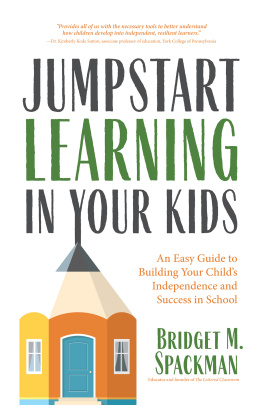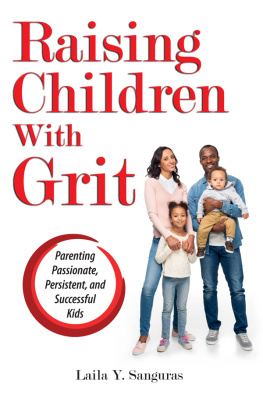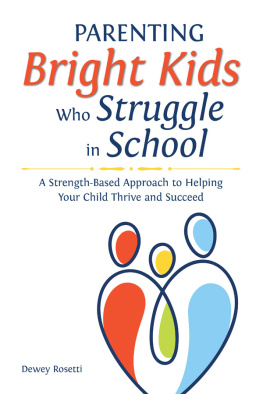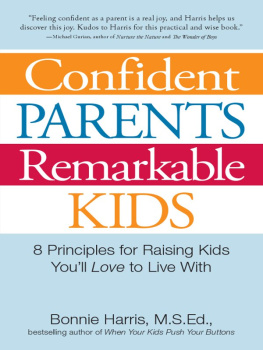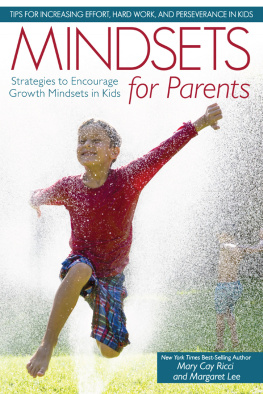Praise for Jumpstart Learning in Your Kids
One of the things that keep you sane once you become a parent is having a good group of parent friends to commiserate with over coffee and at the bus stop. In her new book, Jumpstart Learning in Your Kids , parent and teacher Bridget Spackman becomes that important friend, sharing personal stories culled from her own trial-by-fire experiences, providing all of us with the necessary tools to better understand how children develop into independent, resilient learners and how to support and encourage them along the way.
Dr. Kimberly Kode Sutton, associate professor of e ducation,
York College of Pe nnsylvania
Jumpstart Learning in Your Kids will make parents think differently about how they can support their childs learning in and out of the classroom! Bridget Spackman shares her expertise as both a teacher and parent in a way that makes the information relevant and realistic. All parents should read this book to better understand their childs developmental levels and learn strategies that will increase opportunities for success!
Michelle Ferr, Pocketful of Primary
Supporting children in the classroom and in a home environment are big tasks. In Jumpstart Learning in Your Kids , Spackman beautifully brings her experience as a mother and an educator to help you see growing humans from various perspectives. These insights provide more opportunities to understand, support, and love the wonderful children that we have the privilege of raising.
Juan E. Gonzalez JR., third-gra de teacher
Jumpstart Learning
in Your Kids
An Easy Guide to Building
Your Childs Independence
and Success in School
Bridget Spackman

Coral Gables
Copyright 2021 by Bridget Spackman.
Published by Mango Publishing Group, a division of Mango Media Inc.
Cover Design & Layout: Roberto Nez
Cover illustration: 3d_kot/AdobeStock
Mango is an active supporter of authors rights to free speech and artistic expression in their books. The purpose of copyright is to encourage authors to produce exceptional works that enrich our culture and our open society.
Uploading or distributing photos, scans or any content from this book without prior permission is theft of the authors intellectual property. Please honor the authors work as you would your own. Thank you in advance for respecting our authors rights.
For permission requests, please contact the publisher at:
Mango Publishing Group
2850 S Douglas Road, 2nd Floor
Coral Gables, FL 33134 USA
For special orders, quantity sales, course adoptions and corporate sales, please email the publisher at or +1.800.509.4887.
Jumpstart Learning in Your Kids: An Easy Guide to Building Your Childs Independence and Success in School
Library of Congress Cataloging-in-Publication number: 2021931710
ISBN: (print) 978-1-64250-531-3, (ebook) 978-1-64250-532-0
BISAC category code EDU022000, EDUCATION / Parent Participation
Printed in the United States of America
For my loving parents Nomi and Ma ria Yusafi
Table of Contents
What can I do to help my child at home?
How many times have you silently asked yourself this question after a long day? Maybe youve even asked, or thought about asking, your childs teacher for help. The reality is that many parents have felt this way at some point in their childs life. Feelings of inadequacy or failure often take away any thoughts of reaching out to those around us. Whether youve taken the first step to getting help or have only thought about it, you are doing the right thing. In fact, it takes great courage to be vulnerable with those around us and open up about our uncertainties around parenting and our childs learning. As education continues to evolve and the methods which drive the instruction change, you probably feel overwhelmed and dont know where to start. You are not alone.
As a late bloomer to my education, I didnt graduate college until I was twenty-six years old. By that time in my life, I had already had my first-born, Ian. He was six years old and getting ready to start kindergarten. I interviewed for a few positions and accepted a position as a kindergarten teacher. It was perfect. My little guy and I were starting a new chapter in our lives on the same day, in the very same year, and in the same grade level. For once, I felt as though I was doing someth ing right.
That year I worked hard to step into my new role as a teacher. I started my deep dive into research on strategies for providing good instruction, and I had spent countless hours creating and developing lessons that were hands-on and engaging. I knew that the work that I was putting in was worth it. I wanted nothing more than to be the best teacher I could be for my students, all while working to make a life for myself and for my little boy. It was not going to be easy, but it was the path that I h ad chosen.
What I didnt realize was how time-consuming work was going to be. Id spent four years working to learn everything I could about developmental stages and appropriate teaching methods, and yet I felt completely lost that first year. Teachers will often tell you that you are in survival mode that first year, and they are right. I was in survival mode. While I worked endlessly trying to navigate my way through maintaining a kindergarten classroom, the reality was that I wasnt taking those practices home to my own child.
Coming from a single-mother home and raised by a Hispanic family, my upbringing was slightly different from many others. I loved my childhood and my upbringing, but my experiences or lack of experiences offered different perspectives for me. In turn, that same upbringing is what I gave Ian. For me, education was only a focus while I was in the classroom. It was not like my education was not important. It was! My mother always expected me to do my best. I was to behave in school, listen to my teacher, and get good grades. Those were the expectations, but rarely do I remember being read to or sitting down at the kitchen table to do my work. My mother was working hard to make a life for us. She worked long hours and was tired when she came home. Deep down, I knew that I needed to take care of my responsibilities at school so that I didnt have to burden he r at home.
During the spring of Ians kindergarten year, I was scheduled for a conference with his teacher. I remember this day so well. It was right after school. Ian came into my classroom and I had him stay with a teacher who worked right across the hall from me while I met with his teacher for the conference. As I entered the room, I had two colleagues sitting at the table. This was odd, as a conference was typically only held by the classroom teacher. Only a short way through the conference, his teacher informed me that he was not performing as he should be, and it was their recommendation that he be held back in kindergarten. I cried that day. I cried more than I had in years. For the first time, I felt like a failure as a mother and as a teacher. In my hope to make a life for us, I was distracted from the one thing that mattered most to me. How was I a teacher and yet failing my own kindergartene r at home?
That first year was hard. I struggled to keep myself afloat, and Ian struggled with reading and writing. Despite the recommendations of my colleagues, I decided to have Ian move on to first grade. It took many years of continuing my profession as an educator, getting married, and having another little boy to convince myself that I was not a bad mother. It had also taken years of teaching experience and working closely with families to realize that I was not alone in my feelings and problems.

